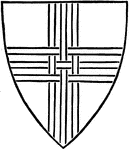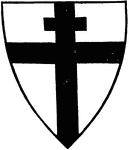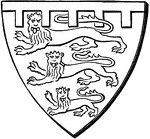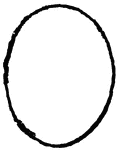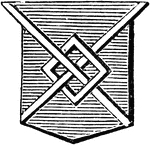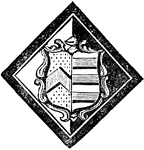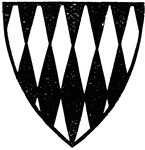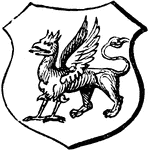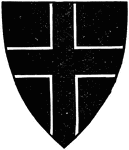
Cross Voided
"A Cross voided is not unlike the Cross double parted, but the bars do not run through or across the…
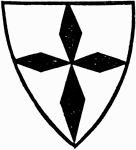
Four Fusils in Cross
"It will be observed that the charge upon the shield in this instance is not the Cross, but the lozenges."—Aveling,…
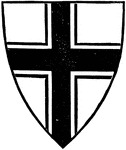
Frimbriated Cross
"The Fimbriated Cross is a cross having a border of another tincture, generally for the purpose of allowing…
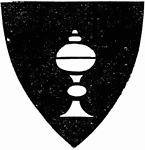
Covered Cup
"An egg-shaped, ornamental, covered cup, with a circular pedestal and base."—Aveling, 1891

Dancette
"Argent, a pale, dancette vert. DANCETTE. A zig-zag figure with spaces between the points, much larger…
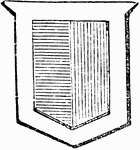
Shield Showing Difference
Differences are shields with a distinguishing charge or bordure. "Party per pale, azure and gules; a…
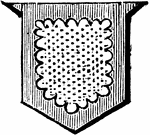
Shield Showing Difference
Differences are shields with a distinguishing charge or bordure. "The annexed example is or, a bordure…
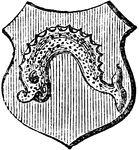
Dolphin Embowed
"Gules, a dolphin naiant embowed or. EMBOWED. Any thing bent or curved, like a bow." -Hall, 1862
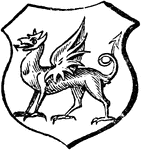
Dragon
"Argent, a dragon proper, tail nowed. DRAGON.. An imaginary monster; a mixture of beast, bird, and reptile.…
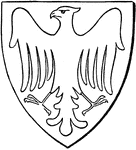
Eagle
The heraldic charge of the eagle is one of the earliest charges. It holds the same rank that the lion…
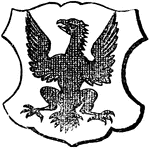
Eagle Displayed
"Argent, an eagle displayed sable. DISPLAYED. A bird whose wings are expanded and legs spread is said…
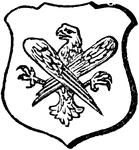
Eagle en Arrière
"Argent, an eagle proper en arrière. EN ARRIÈRE. An expression borrowed from the French,…
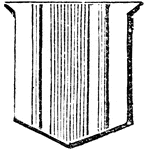
Endorses and Pale
"Argent, a pale between two endorses, gules. The pale has another diminutive one fourth its size; it…
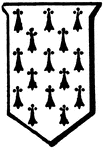
Ermine Shield Fur
A shield or escutcheon emblazoned with the fur, ermine, represented by sable (black) ermine spots on…
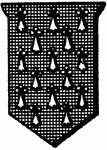
Ermines Shield Fur
A shield or escutcheon emblazoned with the fur, ermines, represented by argent (silver) ermine spots…
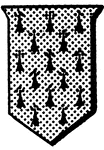
Erminois Shield Fur
A shield or escutcheon emblazoned with the fur, erminois, represented by sable (black) ermine spots…
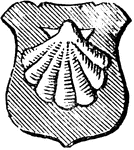
Escalop
"ESCALOP. The shell of a sea-fish, used to decorate the palmers on their way to and from Palestine;…
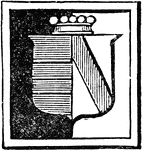
Escutcheon
"ESCUTCHEON. This word is sometimes used to express the whole coat of arms, sometimes only the field…
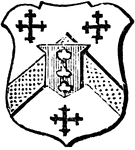
Escutcheon of Pretence
"Argent, a chevron or, between three crosslets sable, on the fess point surtout the chevron an escutcheon…
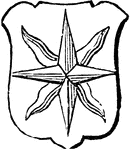
Etoile
"ETOILE. The French word for a star. It differs from the mullet in the number of points, and four of…
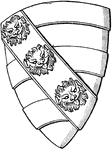
Heraldic Shield with a Lion's Face
The shield of a knight of the time of Edward II. The lion's face is a common charge in heraldry.
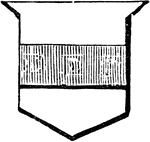
Fess
"Argent, a fess gules. FESS. An honourable ordinary occupying the third part of the shield between the…
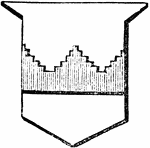
Fess Embattled Grady
"Argent, a fess gules, embattled grady. EMBATTLED GRADY. Where the battlements gradually rise one above…
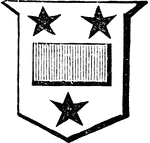
Fess Humetty
"Argent, a fess humetty gules, between three mullets sable. HUMETTY. A term used to denote an ordinary,…
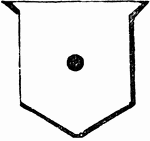
Fess Point
"FESS POINT. The exact centre of the escutcheon, as seen in the annexed example." -Hall, 1862
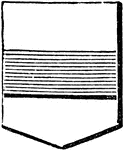
Shield Showing Fess
Gules, two bars, argent. The bar is formed in the same manner as the fess, but it only occupies the…
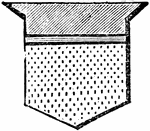
Fillet and Chief
"Or, a chief, purpure, in the lower part a fillet, azure. The chief has a diminutive called a fillet;…
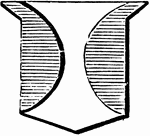
Flanche Ordinary
"Azure, a flanche, argent. The flanche is formed by two curved lines nearly touching each other in the…
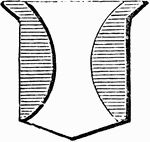
Flasque Ordinary
"Azure, a flasque, argent. In the flasque the curved lines do not approach so near each other." -Hall,…
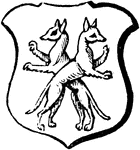
Foxes Counter Salient
"Argent, two foxes counter salient. COUNTER SALIENT. Two animals leaping different ways from each other."…
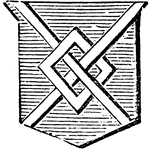
Fret Ordinary
"Azure, a fret, argent. The fret is formed by two lines interlaced in saltier with a mascle." -Hall,…
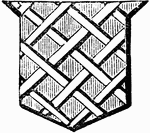
Fretty
"Gules, fretty argent. FRETTY. This word denotes a field covered with fretwork or laths interlacing…
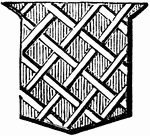
Fretty Ordinary
"Gules, fretty of ten pieces, argent. Fretty is when the shield is covered with lines crossing each…
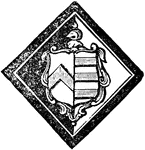
Funeral Atchievement
"The black is left on the dexter side, showing that the husband is deceased, and that his wife survives…
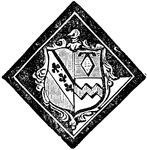
Funeral Atchievement
The image "shows that the husband and his first wife are deceased, and that the second wife is the survivor."…
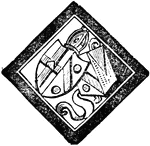
Funeral Atchievement
"The shield on the dexter side of the hatchment is parted per pale; first, the arms of the bishopric;…
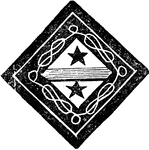
Funeral Atchievement
This image shows "the hatchment of a lady that has died unmarried. The arms of females of all ranks…
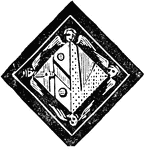
Funeral Atchievement
This image shows "the hatchment of the widow of a bishop; ... here the lozenge-shaped shield is parted…
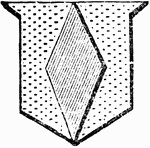
Fusil
"Or, a fusil purpure. THE FUSIL. Is longer than the lozenge: the upper and lower ends are more acute."…
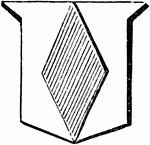
Fusil Ordinary
"Argent, a fusil, purpure. The fusil is narrower than the lozenge, the angles at the chief and base…
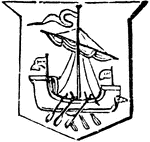
Galley
"GALLEY. An ancient vessel propelled by oars; frequently used in shields of naval officers." -Hall,…

Garbe
"Argent, a garbe proper. GARBE. The heraldic term for a sheaf of any kind of corn." -Hall, 1862
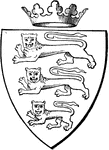
Three Lions Passant Gardant
Three Lions Passant Gardant. The escutcheon shows three lions passant (walking left with a leg raised)…
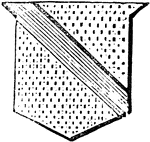
Garter
"Or, a garter vert. GARTER. One of the diminutives of the bend, being half the size." -Hall, 1862
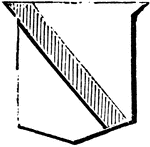
Shield Showing Garter
21 Then the angel of the LORD put forth the end of the staff that was in his hand, and touched the flesh…
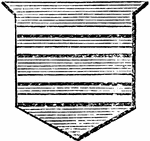
Shield Showing Gemels
Barry of seven pieces, argent and azure. When the shield contains a number of bars of metal and colour…
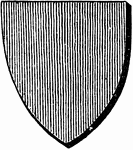
Gules Shield
A heraldic shield with a red (gules) surface, which is represented by the perpendicular lines, drawn…
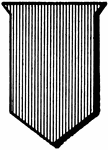
Gules Shield Color
A shield or escutcheon emblazoned with the color tincture, gules (red), represented by vertical lines.
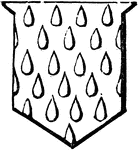
Gutty
"GUTTY. A term derived from the Latin word gutta, a drop. A field bearing drops, as in the example,…
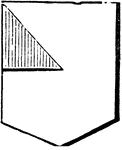
Gyron
"GYRON. A triangular figure formed by two lines from one of the angles of the shield to the centre.…
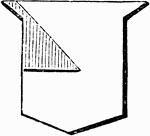
Gyron Ordinary
"The gyron is a triangular figure formed by drawing a line from the dexter angle of the chief of the…
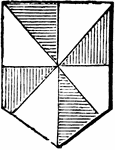
Gyronny
"Gyronny of eight pieces, azure, argent, and gules. GYRONNY. When the field is covered with gyrons,…
